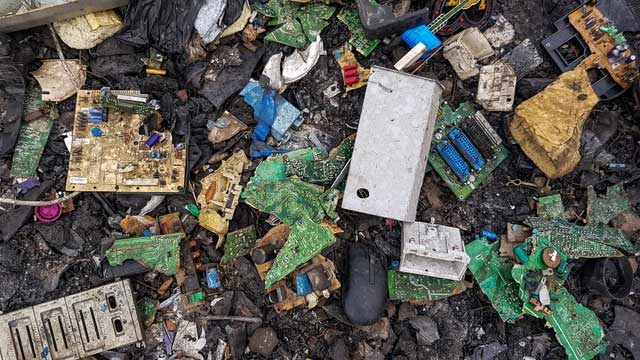The total value of recyclable electronic waste could reach $62 billion, yet it is being neglected, posing risks of pollution and exacerbating global health issues.
A recent report released by the United Nations reveals that in 2022 alone, humanity generated over 68 million tons of electronic waste, enough to fill a fleet of 40-ton trucks lined up along the equator (40,075 km). This figure continues to rise, and according to UN predictions, nearly 3 million additional tons of electronic waste will be released into the environment each year.
Despite this, the recycling of electronic waste is, conversely, on a declining trend.

Most waste consists of small items or devices.
In 2022, only about 22.3% of the total volume of electronic waste was collected and recycled. By 2030, the UN predicts this rate will drop to 20%, while the amount of waste will increase by 33%, equivalent to 82 million tons per year. The reasons include higher consumption rates, shorter product lifespans, and a shrinking range of recoverable and processable components.
Most of the waste consists of small items or devices. Once they are no longer repairable or become obsolete, many continue to be transported around the world in uncontrolled conditions, primarily from high-income countries to those with low or middle incomes.
CBS News reports that they have been tracking this issue since 2008, tracing the recycling of computer parts from the city of Denver (USA) to a toxic landfill in China. According to UN estimates, over 550,000 tons of electronic waste are transported from one country to another each year, but tracking this is extremely challenging as most shipments are exported illegally.
According to the Basel Convention of 1989, most countries are bound by terms controlling cross-border transport and disposal of hazardous waste, including a requirement for each country to have its own electronic waste policy. However, among the 193 countries analyzed, only 81 have implemented policies, laws, or regulations regarding electronic waste.
The economic damage is staggering. The UN report estimates the annual net economic cost of electronic waste at $37 billion. This figure is expected to rise to $40 billion by the end of the decade if the electronics industry does not significantly improve its management and policies.
The total value of recyclable electronic waste is a “treasure” worth up to $62 billion, currently being neglected, while also posing risks of pollution and exacerbating global health issues.
The UN warns that electronic waste, or any discarded product with a plug or battery, contains harmful substances that pose dangers to human health. It also directly impacts the environment, even starting from the initial raw material extraction stages.
For example, to produce 1 kg of gold used in manufacturing printed circuit boards in electronic components, one must extract up to 3,000 tons of mineral ore. Conversely, recovering these resources from similar electronic waste could reduce millions of tons of CO2 emissions into the atmosphere.
Humans can also limit the release of chemicals into the environment by recovering and processing certain types of electronic waste, such as refrigerators, freezers, or air conditioners. If these chemicals are released uncontrollably, they can react with other molecules, thinning the ozone layer, increasing ultraviolet radiation levels at the Earth’s surface, leading to numerous health consequences and contributing to climate change.
The UN emphasizes the need for immediate attention and action to address the rising concern of electronic waste. Although the gap between the quantity of electronic waste and recycling efforts tends to widen, this ratio can still improve if appropriate policies are implemented, such as increasing investments in infrastructure development, promoting the demand for repair and reuse of electronic goods, and building capacity to prevent the import of illegal electronic waste shipments.


















































